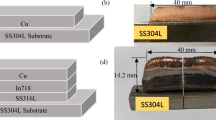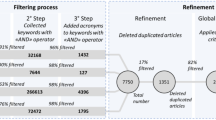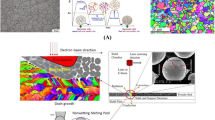Abstract
Component-based simulation workflows can increase the agility of the design process by streamlining adaptation of new simulation methods. We present one such workflow for parallel unstructured mesh-based simulations and demonstrate its usefulness in the thermomechanical analysis of an array of solder joints used in microelectronics fabrication. We automate the simulation process from problem specification to the solution of the underlying PDEs, including problem setup, domain definition, and mesh generation. We establish the utility of the proposed approach by demonstrating that qualitatively different stress concentrations are seen in solder joints near the center of such an array and a solder joint seen at the edge of the same array.







Similar content being viewed by others
References
HPC4Mfg web page (2016) https://hpc4mfg.llnl.gov/
Thomas MP et al (2005) Grid portal architectures for scientific applications. J Phys Confe Series 16:596
Smith CW et al (2015) Enabling hpc simulation workflows for complex industrial flow problems. Proceedings of the 2015 XSEDE Conference: Scientific Advancements Enabled by Enhanced Cyberinfrastructure, p 41
Rossinelli D et al (2013) 11 PFLOP/s simulations of cloud cavitation collapse. 2013 SC-Int Confer High Perform Comp Network Storage Anal (SC) pp 1–13, IEEE
Rudi J et al (2015) An extreme-scale implicit solver for complex PDEs: highly heterogeneous flow in Earth’s mantle. Proceed Int Confer High Perform Comp Network Storage Anal, p 5
Rasquin M et al (2014) Scalable fully implicit finite element flow solver with application to high-fidelity flow control simulations on a realistic wind design. Comp Sci Eng 16(6):13
Shephard MS, Smith C, Kolb JE (2013) Bringing hpc to engineering innovation. Comp Sci Eng 15(1):16
Shephard MS et al (2015) Developing scalable components for massively parallel adaptive simulations. Proc NAFEMS World Congress. San Diego
Mäntylä M (1988) An introduction to solid modeling. Computer Science Press
Hoffmann CM. Geometric and solid modeling
Lienhardt P (1991) Topological models for boundary representation: a comparison with n-dimensional generalized maps. Comp-Aided Design 23(1):59
Ibanez DA, Seol ES, Smith CW, Shephard MS (2016) PUMI: Parallel unstructured mesh infrastructure. ACM Trans Math Software 42(3):17
RPI SCOREC–PUMI. https://www.scorec.rpi.edu/pumi
Smith CW, Rasquin M, Ibanez D, Jansen KE, Shephard MS. Improving unstructured mesh partitions for multiple criteria using mesh adjacencies. SIAM J Sci Comp (submitted)
Zoltan: Parallel partitioning, load balancing, and data-management services. http://www.cs.sandia.gov/Zoltan/
Zoltan2: The trilinos project. https://trilinos.org/packages/zoltan2/
Devine K, Boman E, Heaphy R, Hendrickson B, Vaughan C (2002) Zoltan data management services for parallel dynamic applications. Comp Sci Eng 4(2):90
Rymaszewski EJ, Walsh JL, Leehan GW (1981) Semiconductor logic technology in IBM. IBM J Res Dev 25(5):605
Van Zant P (2014) Microchip fabrication: a practical guide to semiconductor processing, 6th edn. McGraw Hill, New York
Kang SK, Shih D-Y, Bernier WE (2013) Flip-chip interconnections—past, present and future. In: Tong H-M, Lai Y-S, Wong C (eds) Advanced flip-chip packaging Chapter 4, Springer, pp 85–154
Parasolid: Siemens PLM software. http://www.plm.automation.siemens.com/en_us/products/open/parasolid/
Simmetrix inc.—mesh generation, geometry access. http://simmetrix.com/
Geomsim abstract. http://simmetrix.com/products/SimulationModelingSuite/GeomSimAbstract/GeomSimAbstract.html
Meshsim—automatic mesh generation. http://simmetrix.com/products/SimulationModelingSuite/MeshSim/MeshSim.html
Albany home page. https://github.com/gahansen/albany/wiki
Salinger AG et al (2013) Albany: a component-based partial differential equation code built on Trilinos. Technical report, Sandia National Laboratories Livermore, CA; Sandia National Laboratories (SNL-NM), Albuquerque
The trilinos project. https://trilinos.org/docs/dev/packages/sacado/doc/html/index.html
Epetra: The trilinos project. https://trilinos.org/packages/epetra/
Tpetra: The trilinos project. https://trilinos.org/packages/tpetra/
Belos: The trilinos project. https://trilinos.org/packages/belos/
NOX and LOCA: The trilinos project. https://trilinos.org/packages/nox-and-loca/
Zoltan: The trilinos project. https://trilinos.org/packages/zoltan/
Devine K, Boman E, Heaphy R, Hendrickson B, Vaughan C (2002) Zoltan data management services for parallel dynamic applications. Comp Sci Eng 4(2):90
Message passing interface (MPI) forum home page. http://www.mpi-forus.org
Kitware inc. http://www.kitware.com
Open source: Paraview. http://www.kitware.com/opensource/paraview.html
Li Z, Bloomfield MO, Oberai A. A novel rate-objective model for the large-scale simulation of temperature-dependent inelasticity phenomena (In preparation)
Center for computational innovations. http://cci.rpi.edu/
IBM technical computing—overview. http://www-03.ibm.com/systems/technicalcomputing/
Acknowledgements
The authors acknowledge the support of IBM Corporation in the performance of this research. The computing resources of the Center for Computational Innovations, at Rensselaer Polytechnic Institute, are also acknowledged. The development of tools used in this work was partly supported by U.S. Department of Energy, Office of Science, Office of Advanced Scientific Computing Research, under award DE-SC00066117 (FASTMath SciDAC Institute).
Author information
Authors and Affiliations
Corresponding author
Appendix
Rights and permissions
About this article
Cite this article
Bloomfield, M.O., Li, Z., Granzow, B. et al. Component-based workflows for parallel thermomechanical analysis of arrayed geometries. Engineering with Computers 33, 509–517 (2017). https://doi.org/10.1007/s00366-016-0487-5
Received:
Accepted:
Published:
Issue Date:
DOI: https://doi.org/10.1007/s00366-016-0487-5




